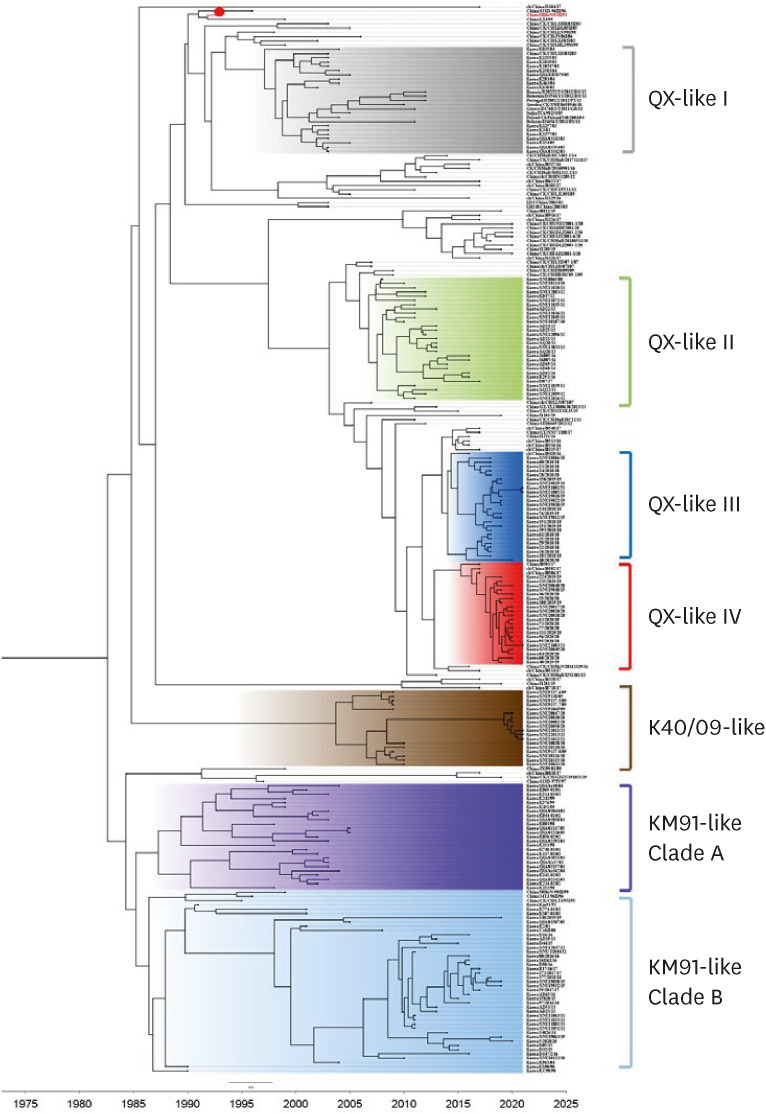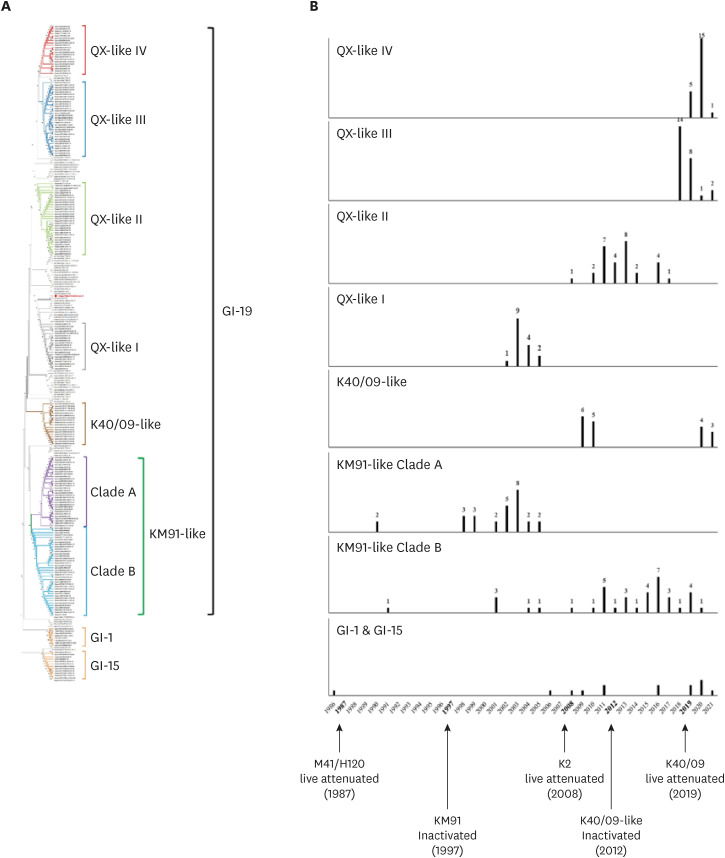传染性支气管炎病毒spike 1蛋白周围的受体结合基序对选择性压力相关突变具有高度易感性。
IF 1.5
3区 农林科学
Q2 VETERINARY SCIENCES
引用次数: 0
摘要
背景:迄今为止,各种基因型的传染性支气管炎病毒(IBV)已经共同传播,在韩国,GI-15和GI-19谱系盛行。刺突蛋白,特别是S1亚基,负责受体结合,包含高变区,也负责新变体的出现。目的:研究GI-19基因变异的主要氨基酸替换。方法:对1986 ~ 2021年在韩国分离的IBV (n = 188)株S1序列数据进行分析。利用快速傅立叶变换对序列进行多重比对。系统发育树是用MEGA-11软件生成的。11.0.10),使用BEAST v1.10.4进行贝叶斯分析。选择压力通过在线服务器Datamonkey进行分析。使用PyMol软件(2.3版)对假定的关键氨基酸进行高亮显示和可视化。结果:韩国的GI-19谱系最多(93.5%),GI-19谱系进一步划分为7个亚群:km91样(A和B枝)、k40 /09样、qx样(I-IV)。km91样ibv和qx样ibv分别在S1的9个和6个残基上鉴定出阳性选择。此外,S1-NTD的几个阳性选择位点即使在产生新枝时也在共同位置发生突变。它们都位于S1亚基的四元结构的外侧表面,靠近受体结合基序(RBM)、推测的RBM基序和S1的中和抗原位点。结论:我们的研究结果表明IBV S1亚基周围的RBM位点在进化过程中极易因选择压力而发生突变。本文章由计算机程序翻译,如有差异,请以英文原文为准。



Receptor binding motif surrounding sites in the spike 1 protein of infectious bronchitis virus have high susceptibility to mutation related to selective pressure.
Background To date, various genotypes of infectious bronchitis virus (IBV) have co-circulated and in Korea, GI-15 and GI-19 lineages were prevailing. The spike protein, particularly S1 subunit, is responsible for receptor binding, contains hypervariable regions and is also responsible for the emerging of novel variants. Objective This study aims to investigate the putative major amino acid substitutions for the variants in GI-19. Methods The S1 sequence data of IBV isolated from 1986 to 2021 in Korea (n = 188) were analyzed. Sequence alignments were carried out using Multiple alignment using Fast Fourier Transform of Geneious prime. The phylogenetic tree was generated using MEGA-11 (ver. 11.0.10) and Bayesian analysis was performed by BEAST v1.10.4. Selective pressure was analyzed via online server Datamonkey. Highlights and visualization of putative critical amino acid were conducted by using PyMol software (version 2.3). Results Most (93.5%) belonged to the GI-19 lineage in Korea, and the GI-19 lineage was further divided into seven subgroups: KM91-like (Clade A and B), K40/09-like, QX-like (I-IV). Positive selection was identified at nine and six residues in S1 for KM91-like and QX-like IBVs, respectively. In addition, several positive selection sites of S1-NTD were indicated to have mutations at common locations even when new clades were generated. They were all located on the lateral surface of the quaternary structure of the S1 subunits in close proximity to the receptor-binding motif (RBM), putative RBM motif and neutralizing antigenic sites in S1. Conclusions Our results suggest RBM surrounding sites in the S1 subunit of IBV are highly susceptible to mutation by selective pressure during evolution.
求助全文
通过发布文献求助,成功后即可免费获取论文全文。
去求助
来源期刊

Journal of Veterinary Science
农林科学-兽医学
CiteScore
3.10
自引率
5.60%
发文量
86
审稿时长
1.3 months
期刊介绍:
The Journal of Veterinary Science (J Vet Sci) is devoted to the advancement and dissemination of scientific knowledge concerning veterinary sciences and related academic disciplines. It is an international journal indexed in the Thomson Scientific Web of Science, SCI-EXPANDED, Sci Search, BIOSIS Previews, Biological Abstracts, Focus on: Veterinary Science & Medicine, Zoological Record, PubMed /MEDLINE, Index Medicus, Pubmed Central, CAB Abstracts / Index Veterinarius, EBSCO, AGRIS and AGRICOLA. This journal published in English by the Korean Society of Veterinary Science (KSVS) being distributed worldwide.
 求助内容:
求助内容: 应助结果提醒方式:
应助结果提醒方式:


